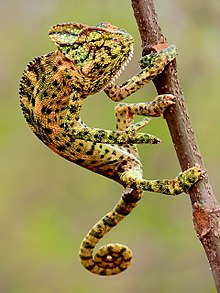Chameleon
| Chameleon Temporal range: Middle Paleocene-Holocene |
|
|---|---|
 |
|
| Chamaeleo zeylanicus in Mangaon, Maharashtra, India | |
| Scientific classification | |
| Kingdom: | Animalia |
| Phylum: | Chordata |
| Class: | Reptilia |
| Order: | Squamata |
| Suborder: | Iguania |
| Clade: | Acrodonta |
| Family: |
Chamaeleonidae Rafinesque, 1815 |
| Genera | |
Chameleons or chamaeleons (family Chamaeleonidae) are a distinctive and highly specialized clade of Old World lizards with 202 species described as of June 2015. These species come in a range of colors, and many species have the ability to change colors. Chameleons are distinguished by their zygodactylous feet; their very extensive, highly modified, rapidly extrudable tongues; their swaying gait; and crests or horns on their brow and snout. Most species, the larger ones in particular, also have a prehensile tail. Chameleons' eyes are independently mobile, but in aiming at a prey item, they focus forward in coordination, affording the animal stereoscopic vision. Chameleons are adapted for climbing and visual hunting. They live in warm habitats that range from rain forest to desert conditions, various species occurring in Africa, Madagascar, southern Europe, and across southern Asia as far as Sri Lanka. They also have been introduced to Hawaii, California, and Florida, and often are kept as household pets.
The English word chameleon is a simplified spelling of Latin chamaeleōn, a borrowing of the Greek χαμαιλέων (khamailéōn), a compound of χαμαί (khamaí) "on the ground" and λέων (léōn) "lion". The Greek word is a calque translating the Akkadian nēš qaqqari, literally "lion of the ground".
The Chamaeleonidae family was divided into two subfamilies, Brookesiinae and Chamaeleoninae, by Klaver and Böhme in 1986. Under this classification, Brookesiinae included the genera Brookesia and Rhampholeon, as well as the genera later split off from them (Palleon and Rieppeleon), while Chamaeleoninae included the genera Bradypodion, Calumma, Chamaeleo, Furcifer and Trioceros, as well as the genera later split off from them (Archaius, Nadzikambia and Kinyongia). Since that time, however, the validity of this subfamily designation has been the subject of much debate, although most phylogenetic studies support the notion that the pygmy chameleons of the subfamily Brookesiinae are not a monophyletic group. While some authorities have previously preferred to use this subfamilial classification on the basis of the absence of evidence principle, these authorities later abandoned this subfamilial division, no longer recognizing any subfamilies with the family Chamaeleonidae. In 2015, however, Glaw reworked the subfamilial division by placing only the genera Brookesia and Palleon within the Brookesiinae subfamily, with all other genera being placed in Chamaeleoninae.
...
Wikipedia
